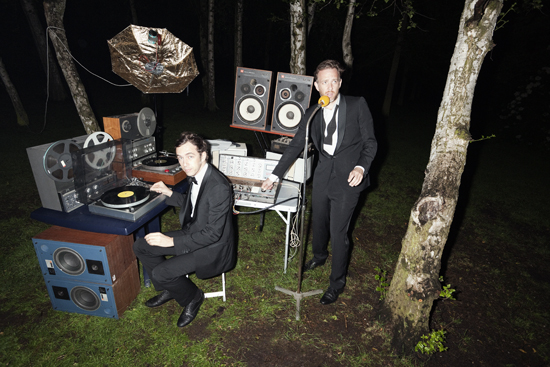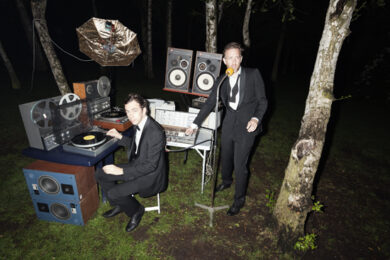Good Brothers of Belgium, David and Stephen Dewaele, have lightened upon a brilliant use of App technology through which to further their ever-interesting Soulwax project. Radio Soulwax is an app that will eventually feature a looping mix of 24 hours of music, each hour being delivered one at at time under its own title and theme. Not only that, but each one is accompanied by its own film, lovingly put together pieces that see the sleeves of the records being played incorporated or drifting in and out of each shot. The Quietus is honoured to be premiering the latest hour of Radio Soulwax’ transmission. Called Into The Vortex it features collie dogs, fruity ladies, giant circular saws in steam, an abused jeep, a really far out photocopier, and mild S&M; and musically feels cosmic, German, futurist electronica. You can’t say better than that for a Friday afternoon, can you? Check it out below, and then read an interview with David Dewaele all about the project below. Download Radio Soulwax on iTunes here and Android here. Visit the Radio Soulwax website.
Into the vortex from Radio Soulwax on Vimeo.
How did you come up with the Radio Soulwax concept?
David Dewaele: Well, it was a bit of a gradual process. We’d been asked many many times to do a follow up to our first (and only) compilation, which came out in 2002 and it had never really felt right to us. We didn’t feel like it made sense anymore these days to spend ages preparing, editing and clearing a compilation CD that is physically limited to just over an hour and would have the shelf life of a month or two at best. It seemed boring to us, so when the time came to we figured we’d do something that fits the way people experience music these days, and that would bring something to the table that our audience couldn’t necessarily already do themselves. We applied for an internet radio license (a fixed amount per year) which allows us to stream whatever we want, as long as we don’t make any money off it. We figured it would take us about six months to make 24 hours of music that would play in a loop, and somewhere along the way we decided to add the visual content and give musical themes for every show, which i am sure you can imagine slowed down the process and eventually kept us busy for over two and a half years.
You’ve always worked across media in a way, being a band/DJ pairing/remix outfit. Was this a logical continuation?
DD: We had gotten quite involved in the making and editing of the Part Of The Weekend Never Dies DVD that documented our tour and our lives about four years ago, and have grown increasingly more interested in the visual side of things, so a few years back we started to bring animations based on the respective record sleeves to our DJ shows and the idea to extend that to Radio Soulwax seemed indeed like a logical continuation, yes. Whether it’s making a remix, producing a band, writing a song or creating visual ideas, it’s all the same part of the brain, really.
Who have you worked with to create the films and how did you develop the concepts?
DD: Steph and i work closely with our friend Fergadelic on the visual ideas for the whole project, whether that is making a logo for a button on the site or coming up with ideas for the visual themes. So for every musically themed hour we went looking for a visual idea that would fit the songs and would still be based on the record sleeves, which has been the most amount work but also the most fun. Sometimes it’s quite frantic and animated and other times the music warrants something more psychedelic or mesmerizing. Depending on the idea, we would then find a suitable animator/filmmaker with the help of our producer Glyn Peppiatt (without whom this whole project would be nowhere btw). Over the last years we have gradually become like a small production company in our own right and have been lucky enough to find a team of amazingly talented people who have been willing to be part of this project for the love of it.
Did the choice of music dictate the concepts, or vice versa?
DD: Yes, the music generally dictates whether we will go for some kind of animation or a film. It tends to go quite quickly these days, and each time we try to come up with an idea that we haven’t done before. There is one show (called Pin Ups) where we actually worked the other way round, where the music is dictated by the sequence of sleeves. And that is because they are all sleeves with naked or semi-naked ladies on them. We’ve gathered about 1500 sexy records and by making connections between the covers, we have to make the music fit, which i can guarantee you is not an easy task, as most of the music on them is crap.
How did the way you approached your selections differ from how you might work elsewhere?
DD: Well, another important factor for us was the fact that musically we could venture out into areas that we generally can’t when playing in front of thousands of people. It’s not a good idea to play an hour of space disco when you headline a festival, it would be indulgent and a waste of energy for everyone, and yet within the context of the radio it makes complete sense.
What was the idea behind Into The Vortex?
DD: All of the musical ideas come from this gigantic iTunes library that we have been working on for over two years, which consists of digitised selections of our vast record collection of about 50,000 vinyls. Every week we would give our team in Belgium a box of records with Post-its attached to them indicating which tracks off the album we have selected for them to digitise, scan the sleeve, and put in the BPM, Key, year, etc… From that ever-growing library, we would then make connections and subsequently playlists that eventually became the 24 hours that are RSWX now, but of course we have many many more that we haven’t made yet. The idea behind Into The Vortex, was to compile a bunch of songs that share the same aesthetic and are all electronic, yet not the kind of thing you would dance to. It’s very hard to find the right adjectives for these tracks as they aren’t exactly esoteric, not krautrock, nor are they ambient, but there are hardly any drums in the mix, they are all quite synthy and psychedelic in the right sense of the word. To give you an idea, Tangerine Dream is the most popular artist in this mix! For the visual side to it, this is actually the first film we gave out of our hands because we believed the concept of rebuilding and remaking the album covers in real life was so strong and we trusted our friend Wim Reygaert to execute it well, and the result is breathtaking and one of the strongest pieces of film of the whole project.
What are your future plans with Radio Soulwax?
DD: We’ll be busy enough as it is releasing all 24 hours over the next four months or so, but eventually we hope that RSWX becomes a platform for all things we like, whether they are pieces of music or films or releases by us or friends or people we have produced. We don’t really tweet or blog or communicate very much with our audience mainly because we haven’t got much to say, so this is ultimately our way of connecting to our crowd.
And forgive us for saying, but these are very high-end productions. Are you not insanely ruining yourselves financially, or do they offer a fiscal hope in these difficult times?
DD: We have been very very lucky that so many people have wanted to work on this project for free or for almost nothing, because as you mention, we have had to pay for the whole thing, and it all adds up! We’re quite fortunate that we can use our live income to fund this crazy labour of love, it might not be the case in a few years’ time so we had to do it now. Everything looks very high-end as you say, but it was actually done on a shoestring budget, which meant that quite often we have had to pause whilst people take on paid jobs and work on RSWX after hours. And then before you know it, you’re two and a half years later.



